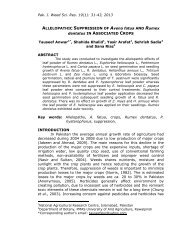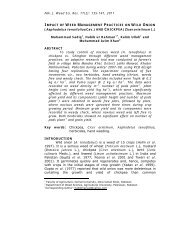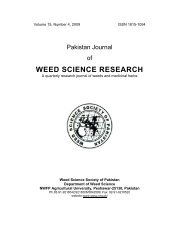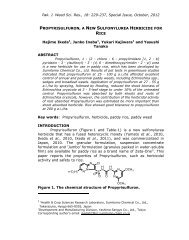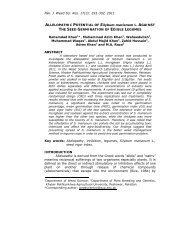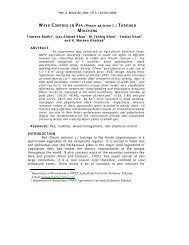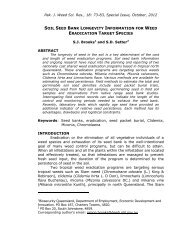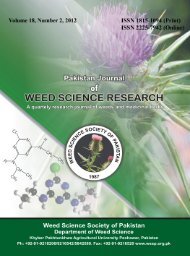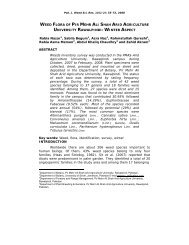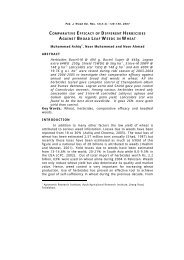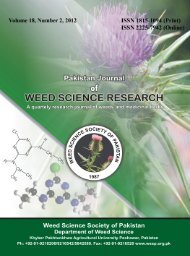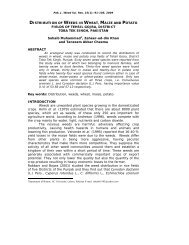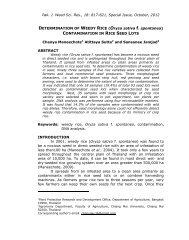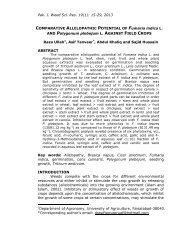A PHYTOSOCIOLOGICAL STUDY OF WEED FLORA ... - Wssp.org.pk
A PHYTOSOCIOLOGICAL STUDY OF WEED FLORA ... - Wssp.org.pk
A PHYTOSOCIOLOGICAL STUDY OF WEED FLORA ... - Wssp.org.pk
You also want an ePaper? Increase the reach of your titles
YUMPU automatically turns print PDFs into web optimized ePapers that Google loves.
Pak. J. Weed Sci. Res. 14(1-2): 81-89, 2008<br />
A <strong>PHYTOSOCIOLOGICAL</strong> <strong>STUDY</strong> <strong>OF</strong> <strong>WEED</strong> <strong>FLORA</strong> IN THREE<br />
ABANDONED FARMLANDS IN OWO AREA, ONDO STATE,<br />
NIGERIA<br />
Olugbenga Ebenezer Ige 1 , Victor Olugbenga Olumekun and<br />
Jacon Olubunmi Olagbadegun<br />
ABSTRACT<br />
A phytosociological study of weed flora from three<br />
abandoned farm lands within Owo Local Government<br />
area of Ondo State, Nigeria, was undertaken. The data<br />
indicated that Chromolaena odorata, Tridax procumbens<br />
and Imperata cylindrica are the most dominant weed<br />
species in the area. The lists of other dominant species<br />
identified in the area are also presented. The weed<br />
biology and its implications for weed management are<br />
discussed.<br />
Keywords: Phytosociology, weed Flora, Nigeria, abandoned farmland.<br />
INTRODUCTION<br />
Ever since man began cultivating plants, he has to fight with<br />
weeds competing with crops for space, water, mineral nutrients and<br />
sunlight. According to Shah et al., (2006), the concept of weeds as<br />
unwanted plants was born when man started to deliberately grow<br />
plants for food.<br />
No matter what definitions are used, weeds are plants whose<br />
undesirable qualities outweigh their beneficial properties. Weeds are<br />
naturally strong competitors to agricultural crops because of their high<br />
adaptability to different environmental conditions and those weeds<br />
that can best compete always tend to dominate. They constitute a<br />
major impediment to agricultural and natural ecosystem in Nigeria.<br />
Primarily, weeds compete with crop plants for light, water and<br />
nutrients (Wang et al., 2007), thereby reducing yields and quality of<br />
produce. They harbour many fungal, viral and bacterial diseases as<br />
well as insects’ pests. In addition to acting as alternate hosts, weeds<br />
provide food for birds, rodents and their predators. Furthermore,<br />
weeds increase labour costs and inputs such as herbicides and may<br />
1 Department of Plant Science and Biotechnology, Adekunle Ajasin University,<br />
Akungba – Akoko, Nigeria, E-mail: olugbengaige@yahoo.com<br />
+2348054733004, +2348034844654.
82<br />
Olugbenga Ebenezer Ige et al. A phytosociological study…<br />
produce chemical substances which are toxic to crop plants<br />
(allelopathy), animals and humans.<br />
There is therefore an urgent need for an effective weed crop<br />
management programme. For such a programme to be visible,<br />
accurate information on the systematics of weeds, their frequency,<br />
density, growth habit, phenology (Alm et al., 1991; Ghersa and Holt,<br />
1995) and weed crop relationships are pre-requisite. But such<br />
information on many tropical weeds, especially in Nigeria, is lacking.<br />
This lack of information forms the basis for carrying out this present<br />
study which is aimed at quantifying the weed flora associated with<br />
shifting cultivation that is widely practiced in Ondo State, Nigeria. The<br />
degree of similarity among the communities and the importance value<br />
index (IVI) of the weed flora was also investigated.<br />
MATERIALS AND METHODS<br />
THE <strong>STUDY</strong> AREA<br />
The study area consists of three sites designated as A, B and C<br />
and they were chosen from within Owo Local Government Area of<br />
Ondo State. These study sites are: Owo, Isuada and Emure Ile (Fig.1).<br />
Site A is an abandoned farmland, very close to the local government<br />
secretariat in Owo. Site B is an abandoned farmland in Isuada while<br />
site C is an abandoned farmland in Emure-Ile.<br />
Owo local government is one of the local governments in Ondo state<br />
and lies between latitudes 50 o 45 o and 7 o 52 o N and longitudes 4 o 20 o<br />
and 6 o 05’E. It is bounded in the North and South by Akoko South<br />
West local government and Edo state, respectively and in the East and<br />
West by Akure North and Ose Local government areas, respectively.<br />
GEOGRAPHICAL FEATURES, VEGETATION AND CLIMATE<br />
The natural vegetation of this area is the lowland tropical<br />
rainforest type, composed of a variety of hard wood timbers. The<br />
rainforest vegetation in Ondo state is among the vegetation that<br />
represents the climax vegetation of the Nigerian forest. In the<br />
Northern district of the state, the vegetation consists of woody<br />
savannah featuring tree species like Blighia sapida and Parkia<br />
biglobosa. The climate consists of distinct wet and dry seasons with<br />
the mean annual temperature of about 20 to 30 o C and high<br />
precipitation (2000-10,000mm yr -1 ). The soil in the study is sandyloam.<br />
The soils derived from the basement complex rocks are mostly<br />
well drained, with medium-to-fine textures which are of high<br />
agricultural value for the production of both tree and arable crops.
Pak. J. Weed Sci. Res. 14(1-2): 81-89, 2008 83<br />
ECOLOGICAL TECHNIQUES<br />
SAMPLING PROCEDURE<br />
Each study site was measured 100m by 100m. Before the<br />
study, each of the sites had been cropped for five growing seasons to<br />
maize, beans, vegetables, cassava, and yam either alone or as mixed<br />
crops.<br />
A rectangular quadrate was used for the weed sampling, and at each<br />
site, a quadrate size of 50 cm 2 was thrown fifty times and the weed<br />
species inside each quadrate were observed, identified and recorded.<br />
The weeds were assessed quantitatively and the information<br />
obtained was used to determine the following ecological parameters.<br />
such as abundance, density, cover, frequency, relative cover, relative<br />
density, relative frequency, index of similarities and importance value<br />
index(IVI) using the method of Kayode and Ige (1998).<br />
RESULTS AND DISCUSSION<br />
A total of 71 weed species belonging to 21 families were<br />
recorded in the study sites (Table-1). In site A (Owo town), 40 weed<br />
species belonging to 17 different families were recorded. Table-2<br />
shows ten dominant weeds in site A. Weeds such as Chromolaena<br />
odorata, Imperata cylindrica and Tridax procumbens were found to be<br />
more common in the community with IVI values of 20.8, 17.5 and<br />
16.5, respectively, and thus the community could be described as<br />
Chromolaena – Tridax – Imperata community.
84<br />
Olugbenga Ebenezer Ige et al. A phytosociological study…<br />
Table-1. Weed families recorded in the three study sites.<br />
S.No. Family Number of species<br />
1. Asteraceae 6<br />
2. Amaranthaceae 3<br />
3 Apocynaceae 3<br />
4. Annonaceae 2<br />
5. Arecaceae 1<br />
6. Combretaceae 2<br />
7. Commelinaceae 2<br />
8. Cucurbitaceae 4<br />
9. Convolvulaeae 3<br />
10. Cyperaceae 4<br />
11 Euphorbiaceae 9<br />
12. Liliaceae 1<br />
13. Loganiaceae 2<br />
14. Malvaceae 4<br />
15. Olacaceae 2<br />
16. Potulacaceae 1<br />
17. Poaceae 11<br />
18. Rubiaceae 5<br />
19. Solanaceae 4<br />
20. Tiliaceae 1<br />
21. Zingiberaceae 1<br />
In site B (Isuada), 49 weed species belonging to 20 different<br />
families were recorded. In this community C. odorata, T. procumbens<br />
and I. cylindrica were also the most abundant with IVI values of 18.2,<br />
14.4 and 16.0, respectively. The ten most dominant weed species at<br />
the locality under reference are presented in Table-3. This community<br />
could also be described as Chromolaena – Tridax – Imperata<br />
community.<br />
In site C (Emure-Ile), 39 weed species belonging to 19 different<br />
families were present. In this community C. odorata, T. procumbens<br />
and I. cylindrica were also the most predominant with IVI values of<br />
17.2, 16.3 and 16.3, respectively. This community could also be<br />
described as Chromoleana – Tridax – Imperata community. Table-4<br />
shows the ten most dominant species.<br />
The families with the highest number of weeds include the<br />
Poaceae, Euphorbiaceae and Asteraceae (Table-1). In this study,<br />
herbaceous weeds recorded constitute about 45 species (68%) while<br />
21 (40%) are woody species. The highest number of herbaceous<br />
species were found in the families Rubiaceae and Cyperaceae which<br />
recorded 5 and 4 species, respectively. Next to this are the families<br />
Apocynaceae and Amarathaceae with 3 species each.
Pak. J. Weed Sci. Res. 14(1-2): 81-89, 2008 85<br />
The number of species in the weed communities ranged from<br />
40 in site (A), 49 in site (B) and 39 species in site (C). The differences<br />
may probably be due to the changes in the surrounding forest<br />
vegetation, anthropogenic activities and the access roads around the<br />
sites.<br />
Excessive weed growth is one of the most important factors<br />
limiting crop production in the tropics. In newly cleared forests, the<br />
major problem is from annual, broadleaved weeds. Although annual<br />
weeds are often very competitive, they generally respond to timely<br />
weeding and other weed control methods.<br />
Because of the negative effect which weeds exert on our<br />
farmlands, there is the need to provide effective weed control<br />
mechanisms. According to Melander et al. (2005), weeds are a<br />
persistent problem in agricultural production systems and considerable<br />
effort has been put into studying and developing chemical, physical<br />
and cultural weed control methods. The idea of controlling weeds is to<br />
limit their negative effects to the level of acceptability. Some of the<br />
biggest problems with weeds in fields of cultivated crops occur in areas<br />
where substantial rainfall occurs throughout the growing season. This<br />
might be the reason behind the presence of this diverse species<br />
recorded in this study as this area receives rainfall throughout the year<br />
because of its location. Similar conclusions have been drawn from<br />
researches on weeds conducted by Martin and Carnahan (1983) and<br />
Buckley et al. (2003). The high moisture level keeps the weed seeds<br />
germinating, and unless the weeds are controlled, they either choke<br />
out and cause crop failure or reduce their yields.<br />
This study has revealed that the study areas could be described<br />
ecologically as Chromolaena – Tridax – Imperata seral communities. C.<br />
odorata (L) King and Robinson; is a perennial weed and belongs to the<br />
family Asteraceae whose production is primarily by wind dispersed<br />
seeds (cypsela) which occur before the rainy season i.e. January–<br />
March. It is rapidly dispersed and is easily established in full sunlight<br />
which makes it an efficient colonizer of disturbed sites. This is the<br />
most widely distributed and highly competitive perennial, broad-leaved<br />
weed. It covers the entire forest in Guinea Savannah zones of Nigeria<br />
and has been reported to have invaded five continents of the world<br />
successfully (Kriticos et al., 2005). It occurs in both field and<br />
plantation crops. Regrowth from the basal stumps establishes so<br />
rapidly during raining season that is difficult to harvest long-season<br />
crops such as cassava and yams. An effective chemical control of<br />
regrowth of this weed is needed.
86<br />
Olugbenga Ebenezer Ige et al. A phytosociological study…<br />
I. cylindrical (L.) Beauv. is an aggressive, rhizomatous<br />
perennial weed with an underground stem that gives out leaves<br />
periodically. It is a member of the family Poaceae and thrives well in<br />
fire prone environments. Its abundance tends to increase with an<br />
increase in its mechanical disturbance. This is one of the most serious<br />
weeds of the cleared forest and guinea savannah zones; especially in<br />
rice, maize, root and tuber crops plantations in Nigeria, though<br />
Macdonald et al. (2006) had reported that this weed does not survive<br />
in cultivated areas of Florida. In addition to competing with crops for<br />
nutrients, light and water, its rhizome, is known to pierce yam tubers<br />
thereby reducing their quality. Seasonal bush burning, a common<br />
practice in this area, induces the plant to flower and set seed thus<br />
contributing to its spread.<br />
T. procumbens L. belongs to the family Asteraceae whose<br />
method of dispersal is by wind. It is a semi prostrate perennial herb<br />
which occurs throughout the tropics and subtropics. It is frequently<br />
found in annual crops, fallow land and occasionally in perennial crops.<br />
Its wide distribution is attributed to its spreading stems and abundant<br />
seed production which is put at between 50- 1500 per plant (Holm et<br />
al., 1997).<br />
Selecting appropriate weed control methods can be very<br />
complex. While weed control principle remain established and<br />
unchanged, the diversity of farming systems can influence both weed<br />
problems and their solutions. It is therefore, difficult to make a list of<br />
recommendation to fit every situation that might arise at any point in<br />
time. However, the integrated weed control approach as canvassed by<br />
several authors (Bond and Grundy 2001; Anderson, 2003; Melander et<br />
al., 2005; Otto et al., 2007) is further stressed.<br />
This study has shown that areas having the same eco-climatic<br />
conditions are likely to support the growth of the same weed species<br />
and the ecological information offered by this study may constitute<br />
strategies to effective weed control.
Pak. J. Weed Sci. Res. 14(1-2): 81-89, 2008 87<br />
Table-2. Ten dominant weed species recorded in site A.<br />
Freq% Basal<br />
Plant Species<br />
Density<br />
IVI<br />
m -2 cover<br />
Chromolaena odorata L. 2.3 56 2.0 20.8<br />
Tridax procumbens L. 1.8 46 2.5 16.3<br />
Imperata cylindrica (L.) 2.0 52 0.1 17.5<br />
Beauv<br />
AspiliaAfricana (P.Beauv. 1.8 44 0.5 9.4<br />
C.D.Adams var. minor<br />
Euphorbia heterophylla L. 1.1 28 1.3 7.1<br />
Eleucine indica L. 1.0 22 1.2 4.2<br />
Ageratum conyzoides L. 1.2 30 0.4 8.7<br />
Cynodon dactylon (L) Pers. 0.4 14 1.0 3.6<br />
Centrosema pubescens L. 0.6 10 0.8 2.1<br />
Boerhavia diffusa L. 0.3 8 1.0 3.0<br />
Table-3. Ten dominant weed species recorded in site B.<br />
Plant species Density m -2 Freq% Basal cover IVI<br />
Chromolaena odorata L 2.9 72 1.5 18.2<br />
Tridax procumbens L. 2.8 70 3.5 14.6<br />
Imperata cylindrical (L.) 2.8 70 0.2 16.0<br />
Beauv.<br />
Amaranthus spinosus (L) 2.6 60 1.3 13.7<br />
Talinium triangulare 2.6 64 0.6 13.8<br />
(Jacq.) Willd.<br />
Aspilia Africana (P.Beauv. 2.2 56 1.1 11.9<br />
C.D.Adams var. minor<br />
Ageratum conyzoides L. 1.2 30 0.4 8.7<br />
Boerhavia diffusa L. 0.8 20 0.5 3.9<br />
Desmodium salicifonium 0.2 8 0.8 2.2<br />
Benth.<br />
Eleusine indica L 0.3 8 1.0 3.0
88<br />
Olugbenga Ebenezer Ige et al. A phytosociological study…<br />
Table-4. Ten dominant weed species recorded in site C<br />
Frequency% Basal<br />
Plant species<br />
Density<br />
IVI<br />
m -2 cover<br />
Chromolaena odorata (L.) 3.0 78 1.5 17.2<br />
King & Robinson<br />
Tridax procumbens L. 2.9 72 1.5 16.3<br />
Amaranthus spinosus L. 2.6 64 0.6 13.8<br />
Aspilia Africana (P.Beauv. 2.0 50 1.1 11.9<br />
C.D.Adams var. minor<br />
Talinium triangulare L. 2.3 58 0.5 6.5<br />
Ageratum conyzoides L. 1.4 3.4 0.5 6.5<br />
Boerhavia diffusa L. 1.0 22 1.3 4.2<br />
Centrosema pubescens 0.4 10 2.0 3.2<br />
Benth.<br />
Desmodium salcifonium 0.6 6 0.8 2.1<br />
(Poiret)DC<br />
LITERATURE CITED<br />
Alm, D.M, J.R.M.E. Mcgiffen, and J.D.Hersketh. 1991. Weed<br />
phenology. In Predicting Crop Phenology. T. Hodges (ed.). CRC<br />
Press, Boca Raton, Florida, USA, pp. 191- 218.<br />
Anderson, R.L. 2003. An ecological approach to strengthen weed<br />
management in the semi arid Great Plains. Adv.Agron. 80: 33-<br />
62.<br />
Bond, W. and A.C.Grundy. 2001. Non chemical weed management in<br />
<strong>org</strong>anic farming systems. Weed Res. 41: 383- 405.<br />
Buckley, Y.M,, D.T. Briese and S.M. Ree. 2003. Demography and<br />
management of the invasive plant species Hypericum<br />
perforatum. I. Using multi-level mixed effects models for<br />
characterizing growth survival and fecundity in a long term data<br />
set. J. Appl. Eco. 40: 481- 493.<br />
Ghersa, C.M. and J.S. Holt. 1995. Using phenology prediction on weed<br />
management : a Review. Weed Res., 35: 461-470.<br />
Holm, L., J. Doll, E. Holm, J. Pancho and J. Herberger, 1997. World<br />
weeds: Natural histories and distribution. John Wiley and Sons.<br />
pp 1129<br />
Kayode, J and O.E.Ige. 1998. A Quantitative study of weed flora in<br />
three Abandoned Farmlands in Ekiti State. Biosci. Res. Comm.<br />
3: 169- 178.<br />
Kriticos, D.J., T. Yonow and R.E.Mcfadyen. 2005. The potential<br />
distribution of Chromolaena odorata (siam weed) in relation to<br />
climate. Weed Res. 45(4): 246- 254.<br />
Martin, R.J. and J.A.Carnahan. 1983. A population model for Noogoora<br />
burr (Xanthium occidentals). Aust. Rangeland J. 5: 54- 62.
Pak. J. Weed Sci. Res. 14(1-2): 81-89, 2008 89<br />
Melander, B., I.A.Rasmussen and P. Barberi. 2005. Integrating<br />
physical and cultural methods of weed control – examples from<br />
European research. Weed Sci. 53: 369- 381.<br />
Macdonald, G.E., B.J.Brecke, J.F.Gaffney, K.A.Langeland, J.A. Ferrell<br />
and B.A.Sellers. 2006. Weeds in the sunshine: Cogongrass<br />
(Imperata cylindria (L.) Beauv. Biol., Eco. and Management in<br />
Florida. UF/IFAS- EDIS Publications.<br />
Otto, S., R.Masin, G.Christe, and G.Zanin. 2007. Modelling the<br />
correlation between plant phenology and weed emergence for<br />
improving weed control. Weed Res. 47: 488 – 498.<br />
Shah, S.R.U., M. Qasim, I.A.Khan and S.A.U.Shah. 2006. Study of<br />
medicinal plants among weeds of wheat and maize in<br />
Peshawar region. Pak. J. Weed Sci. Res. 12 (3):191- 197.<br />
Wang, S, L.Duan, J.Li, X. Tian, and Z.Li. 2007. UV-B radiation<br />
increases paraquat tolerance of two broad leaved and two grass<br />
weeds in relation to changes in herbicide absorption and<br />
photosynthesis. Weed Res. 47(2):122- 128.



